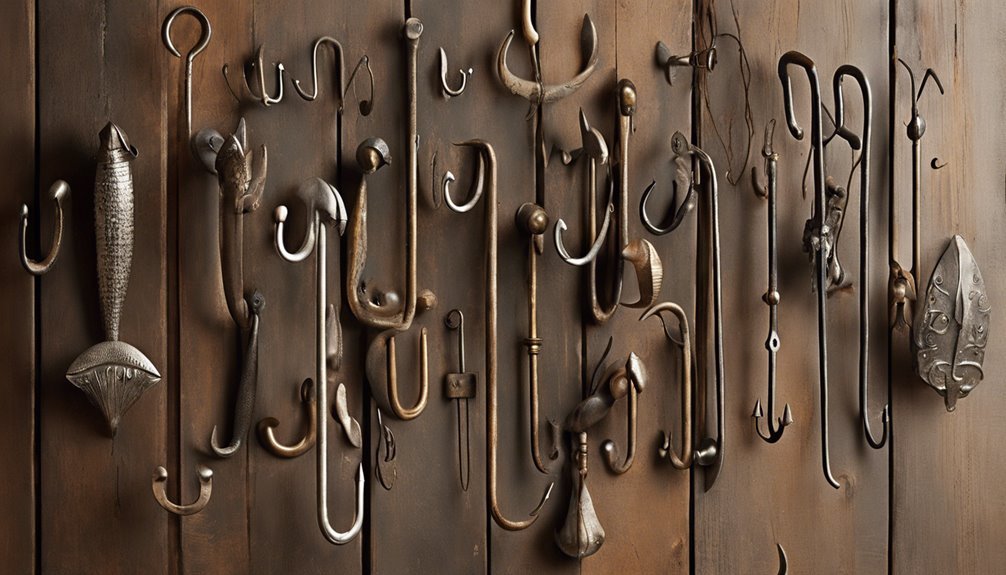History of Hooks and Their Evolution
Hooks have evolved dramatically from their origins in ancient bone and wood designs. These tools were essential for sustenance in early civilizations, reflecting local environments and cultural significance. As craftsmanship advanced, so did innovations in hook design, with modern variations prioritizing ergonomics and sustainability. The impact of industrialization standardized production, diversifying hooks available today. Each unique design serves a specific purpose, demonstrating the hooks' versatility. Discovering the full scope of their history reveals even more fascinating details.
The Origins of Hooks: Early Materials and Designs
While the development of hooks may seem straightforward, their origins reveal a rich tapestry of innovation and resourcefulness. Early hooks emerged from a necessity for primitive fishing techniques, crafted from historical materials like bone, wood, and metal. These materials reflected the environment and available resources, enabling early humans to adapt their fishing strategies. For instance, bone hooks, often shaped with sharp barbs, showcased an understanding of fish behavior, increasing catch efficiency. As you explore these early designs, you'll notice how craftsmanship evolved alongside the changing demands of fishing communities. This evolution not only illustrates human ingenuity but also highlights the fundamental relationship between people and their environment in the pursuit of sustenance and freedom.
The Role of Hooks in Ancient Civilizations
Hooks played an essential role in the livelihoods of ancient civilizations, serving as important tools for both sustenance and trade. In the context of ancient fishing, these implements allowed communities to access crucial food resources, enhancing their survival and economic stability. The design and materials varied greatly, reflecting local environments and available resources. Additionally, hooks weren't just practical; they often held ceremonial significance, symbolizing abundance and prosperity in various cultures. Ceremonial hooks, intricately crafted and adorned, were used in rituals, emphasizing the connection between fishing and spiritual life. This duality of function—both practical and symbolic—illustrates how hooks were integral to the daily lives and cultural practices of ancient societies, weaving together sustenance, commerce, and spirituality.
Innovations in Hook Design Through the Ages
As civilizations evolved, so did the design of fishing hooks, reflecting advancements in materials, technology, and fishing techniques. You'll notice that modern hooks incorporate ergonomic designs, enhancing user comfort and effectiveness. Innovations like barbless hooks have emerged, promoting easy catch and release, aligning with growing sustainability principles. Additionally, the use of sustainable materials, such as biodegradable composites, marks a significant shift towards environmentally friendly practices in fishing. These developments not only improve functionality but also address ecological concerns. As you explore various hook designs, it becomes clear that innovation is driven by a commitment to efficiency and environmental responsibility, enabling anglers to engage with nature while minimizing their ecological footprint.
Cultural Variations and Their Unique Hooks
Fishing practices around the world reveal a fascinating array of unique hook designs, each reflecting the cultural and environmental contexts of their respective regions. The cultural significance of these hooks goes beyond mere utility, showcasing distinct regional styles that highlight local traditions and fishing techniques.
- Barb-less Hooks: Common in catch-and-release practices, promoting sustainability.
- Bone Hooks: Used by indigenous tribes, often adorned with intricate carvings.
- Circle Hooks: Gaining popularity for their effectiveness and conservation benefits.
- Jigging Hooks: Tailored for deep-sea fishing, often featuring vibrant colors.
Understanding these variations enriches your appreciation for fishing as both a practical activity and a cultural expression. Each hook tells a story, woven into the fabric of its community's heritage and environmental interplay.
The Impact of Industrialization on Hook Production
The evolution of hook production has been greatly influenced by industrialization, transforming both the methods of manufacture and the materials used. With the rise of industrial production in the 19th century, hooks shifted from handcrafted items to mass-produced goods. This change allowed for the standardization of sizes and designs, making hooks more accessible to the general population. Additionally, advancements in technology introduced new hook materials, such as stainless steel and plastic, which enhanced durability and functionality. The increased efficiency of production processes not only reduced costs but also expanded the variety of hooks available on the market. Overall, industrialization has played a significant role in shaping the hook industry, reflecting broader societal changes in production and consumption.
Modern Uses of Hooks in Crafts and Industry
Although often overlooked, hooks play a pivotal role in various crafts and industries today. Their versatility in crafting techniques and industrial applications makes them essential tools. Whether you're a hobbyist or a professional, understanding their uses can enhance your creativity and efficiency.
- Knitting and Crocheting: Hooks allow for intricate patterns and textures in textiles.
- Jewelry Making: They enable the assembly of delicate components, enhancing designs.
- Construction and Manufacturing: Industrial hooks support heavy loads, ensuring safety and stability.
- Art Installations: Creative hooks can transform spaces, allowing for dynamic displays.







